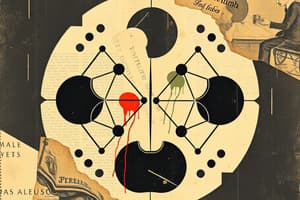Podcast
Questions and Answers
What is the primary purpose of mitosis in multicellular organisms?
What is the primary purpose of mitosis in multicellular organisms?
- To enable growth and repair throughout their lifetime (correct)
- To produce sex cells for reproduction
- To ensure the reproduction of the entire organism
- To increase genetic diversity in offspring
What characterizes somatic cells in terms of chromosome sets?
What characterizes somatic cells in terms of chromosome sets?
- They have four sets of chromosomes
- They have two sets of chromosomes (correct)
- They have a variable number of chromosomes
- They have only one set of chromosomes
During cell division, sister chromatids are joined together at which specific region?
During cell division, sister chromatids are joined together at which specific region?
- Nucleus
- Telomere
- Chromatid region
- Centromere (correct)
How many sets of chromosomes do gametes contain?
How many sets of chromosomes do gametes contain?
What is the result of most cell divisions, such as mitosis?
What is the result of most cell divisions, such as mitosis?
Which statement accurately describes meiosis?
Which statement accurately describes meiosis?
What happens to chromosomes as a cell prepares for division?
What happens to chromosomes as a cell prepares for division?
What term describes the complete set of genetic information in a cell?
What term describes the complete set of genetic information in a cell?
What happens to a cell that does not receive a go-ahead signal at the G1 checkpoint?
What happens to a cell that does not receive a go-ahead signal at the G1 checkpoint?
Which type of tumor tends to remain at the original site without invading surrounding tissues?
Which type of tumor tends to remain at the original site without invading surrounding tissues?
What role does the p53 gene play in normal cell division?
What role does the p53 gene play in normal cell division?
What distinguishes malignant tumors from benign tumors?
What distinguishes malignant tumors from benign tumors?
What characteristic of cancer cells allows them to escape normal cell cycle controls?
What characteristic of cancer cells allows them to escape normal cell cycle controls?
What is the primary role of the mitotic spindle during mitosis?
What is the primary role of the mitotic spindle during mitosis?
What initiates the assembly of spindle microtubules in animal cells?
What initiates the assembly of spindle microtubules in animal cells?
What are kinetochores associated with?
What are kinetochores associated with?
During which phase do sister chromatids move towards opposite ends of the cell?
During which phase do sister chromatids move towards opposite ends of the cell?
What structure is formed by overlapping nonkinetochore microtubules?
What structure is formed by overlapping nonkinetochore microtubules?
At what point are chromosomes aligned at the metaphase plate?
At what point are chromosomes aligned at the metaphase plate?
What occurs during telophase?
What occurs during telophase?
What is true about the centrosome during mitosis?
What is true about the centrosome during mitosis?
What happens to the spindle after cytokinesis begins?
What happens to the spindle after cytokinesis begins?
Which component will NOT be found in a mitotic spindle?
Which component will NOT be found in a mitotic spindle?
What process occurs during cytokinesis in animal cells?
What process occurs during cytokinesis in animal cells?
In plant cells, what structure is responsible for forming a new cell wall during cytokinesis?
In plant cells, what structure is responsible for forming a new cell wall during cytokinesis?
What is the asexual reproduction method utilized by prokaryotes?
What is the asexual reproduction method utilized by prokaryotes?
Which molecule is primarily responsible for regulating the frequency of cell division?
Which molecule is primarily responsible for regulating the frequency of cell division?
What role do external signals play in the cell cycle?
What role do external signals play in the cell cycle?
What is a key feature of binary fission in bacteria?
What is a key feature of binary fission in bacteria?
What initiates the replication of chromosomes in prokaryotes during binary fission?
What initiates the replication of chromosomes in prokaryotes during binary fission?
What is the primary function of the S phase in interphase?
What is the primary function of the S phase in interphase?
What type of control is involved in the regulation of the eukaryotic cell cycle?
What type of control is involved in the regulation of the eukaryotic cell cycle?
What is NOT a likely consequence of malfunction in the cell cycle control system?
What is NOT a likely consequence of malfunction in the cell cycle control system?
In which phase of the cell cycle does the cell spend the majority of its time?
In which phase of the cell cycle does the cell spend the majority of its time?
Which of the following correctly sequences the phases of mitosis?
Which of the following correctly sequences the phases of mitosis?
How do eukaryotic cells differ from prokaryotic cells in cell division?
How do eukaryotic cells differ from prokaryotic cells in cell division?
What does cytokinesis specifically refer to in the context of cell division?
What does cytokinesis specifically refer to in the context of cell division?
During which phase does the nuclear envelope break down?
During which phase does the nuclear envelope break down?
Which statement best describes G2 phase in interphase?
Which statement best describes G2 phase in interphase?
Which phase of mitosis immediately follows metaphase?
Which phase of mitosis immediately follows metaphase?
What occurs during the G1 phase of interphase?
What occurs during the G1 phase of interphase?
What role do centrosomes play during mitosis?
What role do centrosomes play during mitosis?
What characterizes interphase compared to the mitotic phase?
What characterizes interphase compared to the mitotic phase?
Flashcards
Mitosis
Mitosis
The process by which a cell divides into two daughter cells, each with identical genetic information, called DNA.
Genome
Genome
The complete set of genetic material in an organism, composed of DNA.
Somatic cells
Somatic cells
Nonreproductive cells that make up the majority of an organism's body.
Gametes
Gametes
Signup and view all the flashcards
Centromere
Centromere
Signup and view all the flashcards
Sister chromatids
Sister chromatids
Signup and view all the flashcards
Chromatid separation
Chromatid separation
Signup and view all the flashcards
Meiosis
Meiosis
Signup and view all the flashcards
Interphase
Interphase
Signup and view all the flashcards
G1 phase
G1 phase
Signup and view all the flashcards
S phase
S phase
Signup and view all the flashcards
G2 phase
G2 phase
Signup and view all the flashcards
Cytokinesis
Cytokinesis
Signup and view all the flashcards
Prophase
Prophase
Signup and view all the flashcards
Metaphase
Metaphase
Signup and view all the flashcards
Anaphase
Anaphase
Signup and view all the flashcards
Telophase
Telophase
Signup and view all the flashcards
Cell Cycle Checkpoint
Cell Cycle Checkpoint
Signup and view all the flashcards
G1 Checkpoint
G1 Checkpoint
Signup and view all the flashcards
Cancer
Cancer
Signup and view all the flashcards
Tumor Suppressor Gene
Tumor Suppressor Gene
Signup and view all the flashcards
Mitotic Spindle
Mitotic Spindle
Signup and view all the flashcards
Kinetochore Microtubules
Kinetochore Microtubules
Signup and view all the flashcards
Kinetochores
Kinetochores
Signup and view all the flashcards
Metaphase Plate
Metaphase Plate
Signup and view all the flashcards
Nonkinetochore Microtubules
Nonkinetochore Microtubules
Signup and view all the flashcards
Cleavage furrow
Cleavage furrow
Signup and view all the flashcards
Cell plate
Cell plate
Signup and view all the flashcards
Binary fission
Binary fission
Signup and view all the flashcards
Growth factor
Growth factor
Signup and view all the flashcards
Cell cycle control system
Cell cycle control system
Signup and view all the flashcards
Frequency of cell division
Frequency of cell division
Signup and view all the flashcards
Internal controls
Internal controls
Signup and view all the flashcards
External controls
External controls
Signup and view all the flashcards
Study Notes
Cell Cycle
- Continuity of life depends on cell reproduction, or cell division
- Unicellular organisms reproduce by cell division
- Multicellular organisms rely on cell division for growth and repair
- Cell division can develop from a fertilized cell (zygote)
Most Cell Division Results in Genetically Identical Daughter Cells
- Most cell division (mitosis) produces daughter cells with identical genetic information (DNA)
- Meiosis is a special type of cell division for producing sperm and egg cells
- The genome is all the DNA in a cell
- Single DNA molecule in prokaryotic cells
- Multiple DNA molecules in eukaryotic cells
- DNA in eukaryotic cells is organized into chromosomes
- Every eukaryotic species has a specific number of chromosomes per cell nucleus
- Somatic cells (non-reproductive cells) have two sets of chromosomes
- Gametes (reproductive cells) have half the number of chromosomes as somatic cells (one set)
Distribution of Chromosomes During Eukaryotic Cell Division
- Before cell division, DNA is replicated, and chromosomes condense
- Each duplicated chromosome has two sister chromatids (joined copies of the original chromosome) that separate during division
- The centromere is the narrow "waist" of the duplicated chromosome, where sister chromatids are most tightly attached
Stages of Mitosis
- During mitosis (cell division), two sister chromatids of each duplicated chromosome separate and move into two nuclei
- Once separated, the chromatids are called chromosomes
The Cell Cycle
- The cell cycle is the life cycle of a cell, from formation to division
- Interphase (about 90% of the cell cycle)
- G1 phase ("first gap"): cell growth
- S phase ("synthesis"): DNA replication
- G2 phase ("second gap"): preparation for mitosis
- Mitotic (M) phase: mitosis and cytokinesis
Eukaryotic Cell Division
- Mitosis is the division of the genetic material (DNA) within the nucleus, divided into 5 phases:
- Prophase
- Prometaphase
- Metaphase
- Anaphase
- Telophase
- Cytokinesis: the division of the cytoplasm
Mitosis Stages Summarized (P.M.A.T)
- Prophase: Chromosomes condense, nuclear envelope breaks down, and spindle fibers form
- Metaphase: Chromosomes align in the middle of the cell
- Anaphase: Sister chromatids separate and move toward opposite poles
- Telophase: Two new nuclei form, chromosomes decondense, nuclear envelope reforms
The Mitotic Spindle
- The spindle is a microtubule-based structure that controls chromosome movement
- Mitotic spindle = centrosomes + spindle microtubules + asters
- Centrosome: microtubule-organizing center
- Centrosome replicates during interphase, forming two centrosomes that migrate to opposite ends of the cell
- Spindle microtubules attach to kinetochores of chromosomes to move the chromosomes
- Kinetochores are protein complexes associated with centromeres
Mitosis Continued
- In anaphase, sister chromatids separate, move along kinetochore microtubules to opposite poles.
- Nonkinetochore microtubules overlap and push against each other, elongating the cell
- In telophase, genetically identical daughter nuclei form at opposite ends of the cell
- Cytokinesis begins in anaphase or telophase
Cytokinesis
- In animal cells, cytokinesis occurs via cleavage, forming a cleavage furrow
- In plant cells, a cell plate forms
- Vesicles form the cell plate, which will form the new cell wall
Cell Cycle Control System
- Frequency of cell division varies depending on cell type
- Cell cycle is driven by specific chemical signals (in cytoplasm)
- Growth factors: proteins released by cells that stimulate cell division
- Checkpoints (G1, G2, M) regulate the cell cycle (where the cell cycle stops until a go-ahead signal is received)
- The G1 checkpoint is most important for most cells
Loss of Cell Cycle Controls in Cancer Cells
- Cancer cells escape usual cell cycle controls
- Cancer cells can make their own growth factors to grow/divide
- Transformation: when a normal cell becomes a cancerous cell
- Tumors: masses of abnormal cells within otherwise normal tissue
- Benign tumors stay localized
- Malignant tumors can metastasize (spread to other parts of the body)
- Recent advances in cell cycle understanding have improved cancer treatment
Cancerous Cells
- Characteristics of cancerous cells include variations in size and shape, a larger and darker nucleus than normal cells, and an abnormal number of chromosomes
- Sarcomas: tumors in connective tissue
- Carcinomas: tumors in epithelial tissue (frequently associated with lung, colon, breast, and leukemia/lymphomas)
- The frequent cell division in epithelial cells makes them prone to genetic mutations
- 90% or more of adult cancers arise in epithelial tissues
p53 Gene
- p53 is a tumor-suppressor gene
- Cancer cells repeatedly undergo cell division without being halted at the G1 checkpoint when p53 is nonfunctional
Studying That Suits You
Use AI to generate personalized quizzes and flashcards to suit your learning preferences.




